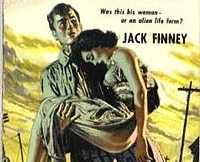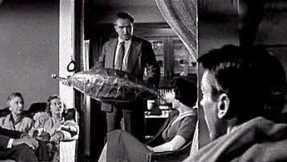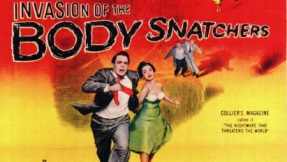Invasion of the Body Snatchers: An American Commentary

The Hollywood remake is a curious thing – curious in the sense it’s either the dog’s dinner or the dog’s bollocks. For every Cape Fear, there are a hundred Nightmare on Elm Streets. To find the ones worth watching, you’d need industrial-standard wellies and a metal detector to make your way through the incessant torrent of shit in search of gold.
Remakes find it hard to shake the stigma of being low-grade cash grabs – now at least. The horror genre is the worst offender. Silicon implants and digital blood splatter cling to the reputation of cult classics like Texas Chainsaw Massacre and Friday the Thirteenth without offering unique or fresh ideas.
Enter on cue; stage left: Philip Kaufman
Before Invasion of the Body Snatchers succumbed to the incubus-like tendencies of Hollywood’s fat cats in 1993 (and again in 2007), Kaufman turned out a chilling Seventies update of Don Siegel’s intimately unsettling original. And so, for the purposes of the article, the recent interpretations will not be discussed, though they serve to show the modern-day remake as an abash scam by lesser individuals, clambering on the shoulders of giants like fleas on a mutt.
Spoiler Alert: The endings to the 1956 and 1978 Invasion of the Body Snatchers will be discussed in this article – you have been warned.
The premise is simple. An alien race slips onto Earth unnoticed and begins a radical overhaul of the human race – through biological duplication and deletion, whilst sapping their host of any emotion and feeling. Panic ensues. Despite the film’s own chronic duplication over the years, the source material was not a work universally loved by critics.

Jack Finney’s Invasion of the Body Snatchers appeared serially in Colliers Magazine in 1954 before being compiled as the first edition a year later. However its influence is seen in earlier works around the same time. Robert A. Heinlein’s 1951 novel, The Puppet Master (adapted into a feature film in 1994), detailed the American Government’s struggle against mind-controlling aliens; and John W. Campbell Jr’s 1938 novella, Who Goes There? (the original story behind The Thing from Another World and John Carpenter’s The Thing) saw a scientific research team battle a shape-shifting entity amidst Arctic blizzards.
This was the story’s inevitable shortcoming, with popular fiction critic Groff Conklin stating in Galaxy magazine ‘too many sci-fi novels lack outstanding originality, but this one lacks it to an outstanding degree.’ In a 1967 retrospective on Body Snatchers, Damon Knight attacked the novel’s scientific anomalies and forced plot development, particularly Finney’s misplaced grasp on Arrhenius’ spore theory and the protagonists’ inability to think as separate beings from the author – becoming unintentional variations of the narrative’s pod people. However, sci-fi editor Anthony Boucher lauded Finney as ‘unpredictably ingenious’ in the Magazine of Fantasy and Science-Fiction.
With such a putrid critical response it’s easy to see why they made a film a year later … right?
Despite the novel’s apparent flaws, there was something lurking in its pages, like a heckler in the rafters of the paranoid performance that was American suburbia.
The Fifties was a time of tension between East and West, with Communism spreading from its Russian origin and America waving the flag for Capitalism. Stretching as far back as 1947, supposed Communist supporters were continually blacklisted regardless of any previous standing they had held, and any hopeful productions, along with all involved, were given a vigorous background check to clear their names of any affiliation with Marxist beliefs.

For Don Siegel, this climate was like a petri dish for his brand of filmmaking. He was a character known for making low-budget pictures with a hard bite. It was under the guise of the B-movie that directors like Siegel and Samuel Fuller were able to voice their growing concern. Working in the very nooks and crannies of the Hollywood backlots and sound stages, they were able to go unnoticed by their more ‘successful’ peers; and by shooting films in the sci-fi and western genre, were able to get away with a nibble at American society. Producer Walter Wanger (a vocal liberal in the industry) made the movie Riot in Cell Block 11 with Siegel, which examined the state of the prison system (where he spent a significant amount of time after shooting an agent) which surprised both parties; sitting well with both critics and audiences. Together, along with scriptwriter Daniel Mainwaring, they decided to reincarnate the growing presence of conformity and ‘McCarthyism’ as a visual retelling of Finney’s Invasion of the Body Snatchers.
The production lasted less than a month (and that was three days behind schedule) and shot on a budget of $380,000 – typical of Siegel picture. It’s also typical that Siegel only spent $15,000 on special effects as he was conscious of the film transforming into a run-of-the-mill monster movie. He was a man known to stretch the dollar as far is it would; capturing shots on sound stages he wasn’t permitted to use and hiring strong character actors to give his scenes added punch and gravitas (Straw Dogs director Sam Peckinpah appears as a meter reader).

The result was an eerie, sombre analysis of conformity, which stands along William Whyte’s work The Organization Man as a charge from popular culture against a decade obsessively focused on fitting in amidst the threat of Communism; and, ironically, a paranoid fear of losing one’s individuality. The aptly named ‘pod-people’ are Communist in their very nature. They seek to standardise the human race and make Earth a level playing field, through the means of forceful and efficient duplication. In this sense, the film is not pro-Communist. Its antagonists are merciless in executing their plan, which ultimately results in their demise. As detailed in the source material, they are unable to reproduce and therefore, the human race would be led to extinction, before the symbiotic host moves to another planet. The scenes where Miles (Kevin McCarthy) discovers his secretary is a pod-person; and the epilogue, where he recounts the events to the authorities of the invasion, scream McCarthyism – the act of accusing a person of disloyalty, despite a lack of evidence. If Miles was to stay silent, the pod-people would spread beyond the borders of Santa Mira. How could he let it happen? And how could America let Communism continue to trickle through its wholesome communities with a possible nuclear war looming over its head?
Yet Siegel wasn’t convinced by the ending. The epilogue was a result of studio interference (typically) to give the viewing public hope for a successful outcome. Originally, the film was to end with Miles warning people on the highway that they were ‘next’, and to leave the audience feeling the inevitable dread and size of the situation.
And that is where Kaufman comes in.
A film should only be remade for certain, very exclusive, reasons. You can argue for a reinterpretation if the original wasn’t up to scratch (like David Cronenberg’s re-imagining of The Fly). But the truly creative directors can spot that special something in a film; a thing that a director can twist and model like clay to match the current generation, while still maintaining the soul of the predecessor. This is why Kaufman’s Body Snatchers is a strong contender for the greatest remake of all time.

First of all, the ending. THAT ending. Donald Sutherland has often been described as hit-and-miss but his grounded performance here should rank along Don’t Look Now (1973) as one of his strongest. We see his character, Matthew, going to work some time after Elizabeth’s (Brooke Adams) duplication and deterioration at the docks. We know that the body snatchers have reached pandemic proportions as a ship carried a multitude of pods to the American shore. This is the first change to the original climax. But now we see Matthew sitting at his desk; his face vacant. We question ourselves. Has he been captured and snatched? Or is he pretending for the pod-people as we saw earlier on; to evade their clutches? It is only when Nancy (Veronica Cartwright), who lasted so long on her own, calls to him and breaks her act, that we see the truth in one of the most unnerving finales in sci-fi. To spoil it completely would be an injustice to those who haven’t seen it, but Kaufman elevates the feeling of hopelessness far beyond what Siegel had envisioned.
Few remakes can boast having as much social significance as the former, and even fewer can boast being equally significant for entirely different reasons. Yet the genius behind Kaufman’s Body Snatchers is in the setting. He plotted the invasion in San Francisco rather than the fictional Santa Mira. W.D Richter’s script still remains faithful to the inspiration, though the swap in location now seems necessary to convey a new social allegory.

Stepping out from the shadow of the Soviet threat, the 1978 film focuses its eye on the ‘Me’ decade that was the Seventies. San Francisco (and even more specifically Haight-Ashbury) was a city notorious for its free-loving, hippie community – a movement that revelled in what it means to feel and to love. Yet the city had succumbed to urbanisation and thus, its inhabitants had grown alienated from each other, and this is what Kaufman portrays; not a fear of the damn Commies, but the dehumanization of a people in an urban environment. His pod-people no longer feel the emotional connections that friendships, working relationships and romance bring. Kaufman ponders the question: ‘do we really know our lovers and our friends?’ But he does not answer it through his pod-people alone; he goes about it through his characters’ interactions with the alien beings. We can only watch with unease as Elizabeth begins to doubt her partner Geoffrey; not that he is still human, but what he is doing, where he is going and who he is seeing – she only knows that he is lacking in something that makes him human; though it something she cannot place her finger on. In short, Kaufman’s emotionless body snatchers were the physical incarnation of a nation’s struggle against alienation in the endless sea of bodies of America’s major cities.
Of course, the social commentary is a welcome addition to both films, but not essential to enjoy the viewing experience. They exhibit a wonderful use of practical effects and deliver on various levels of terror. As well as pointing the finger at two American societies in silent turmoil, Siegel and Kaufman managed to produce wonderful pieces of art that continue to inspire and scare filmmakers and audiences alike. Let it be said that Invasion of the Body Snatchers (1978), along with The Fly (1986) and The Thing (1982), continues as a shining example of not only what it means to be a science-fiction film but what it means to be a remake of the highest quality.
What do you think? Leave a comment.











Very interesting stuff.
Watching the DVD with commentary by director Kaufman, you gain an even greater appreciation when you hear how thoughtful he was in making this film and about all the little subtle touches/background details included by him and why he did them (within the context of the story).
Very true. Did you notice Robert Duvall as the priest on the swing at the beginning? It’s things like that, tiny little things, that elevated this film further than the original I feel.
Thanks for reading.
…This one really is a sci-fi horror classic. The atmosphere was just so isolating and filled with dread and man that ending… WOW. What a chiller.
I knew nothing about the film before I watched it the first time, watched it at 3 in the morning – that ending was just the icing on a very unnerving night!
Thanks for reading.
Nice study. I must admit that I liked the 78 one better than the original. The only good thing in my opinion about the original, was Dana Wynter, who i think it`s pretty. I like this, the 78 version much more. I have it on dvd, but i will buy the Blu-ray later this month.
Er, no. This is a solid film, but the original is a masterpiece. This biggest problem with this film in regards to the original is that unlike THE THING and THE FLY which are both very different to the originals this is virtually a point-by-point remake and despite being 40 minutes longer the only thing this movie adds is nudity, gore and explosions.
They’re both masterpieces. While The Thing and The Fly are very different to their originals (and that’s why they were very good remakes), Kaufman didn’t set out to do the same thing. He understood the social commentary and shaped it around the current climate, plus he restored, tonally at least, the ending Siegel had always wanted. Yes it is a very similar story, but to change too much would have lessened the significance of the allegory.
I go between both of them to be honest, sometimes I prefer the original, others I prefer the 78 version. It just depends on my mood haha! The new blu ray release looks phenomenally restored, though it still has the sound problems with people getting a little too quiet the further away from the camera they get.
The directing is still very tight and there is a great building tension and paranoia. The first half is better than the second half and I already knew the ending because of the show Community, but it’s still a great movie with some great acting. And the flat out scariest part was the man/dog hybrid!! F that S!!! Or when Matthew falls asleep in his garden. I would like to know how Nancy was able to survive for so long? And why was Robert Duvall in this for 10 seconds?
I thought the pod scene in the garden was horrific, a bit like the scene in the kennel in The Thing. And I seem to remember reading that they got Duvall to appear by giving him a jacket haha!
Kaufman’s Snatchers is one of the freakiest movies ever. I like your in-depth description of the ending. Props also for referencing Don’t Look Now, Sutherland’s other 70s genre classic, but why no mention of his participation in the 1994 Puppet Masters film?
Regrettably I haven’t seen Puppet Masters, though I have heard good things. Should I go out of my way to see it? And thanks for reading!
I always really liked this one SUFFOCATINGLY CREEPY camera shot in the film that happens near the beginning.
It’s when Elizabeth confronts Matthew at the elevator in the Public Health Building, with tears in her eyes. And Matthew has no idea what’s wrong with her, but we know that she’s seen and realized something horribly wrong not just with Geoffrey, but with the city.
And right after they embrace next to the elevator, there’s this brilliant dolly shot of the camera going down the hallway and approaching the janitor as he’s sweeping the floor with his electric broom thing, back and forth, the hum of the device creating an eerie background noise. And although his face is shadowed he is looking straight ahead with a blank expression.
I don’t know, but that one shot summarized the whole terror of the film for me.
YES! that’s when the film really took off for me, it’s a slow burner up until that point I’ve found, but that feeling of growing concern and that they can’t trust anyone really shows itself there.
Also when Leonard Nimoy gives that look to those police officers when Matthew tries to alert them to Elizabeth’s pod-person. Creepy stuff!
Thanks for reading!
I am a huge fan of Invasion of the Body Snatchers. Thought this was a total pleasure to read.
Thank you, Sam. It means a lot to get positive feedback, I like your taste in films!
I wonder if some of the heartless qualities of the Kaufman flick can be attributed to the fact that the 70’s is the only decade in which directors were allowed to deliver big films that were total bummers, almost as a matter of style. Also released in 1978: The Deer Hunter, Dawn of the Dead, The Boys From Brazil. These were great films, but they were as dark and hopeless as Donald Sutherland’s gaping craw in the last shot of Invasion of the Body Snatchers. What a lovely movie.
Both versions of Invasion are great – thanks for writing an article about both.
I agree with you when you wrote that “…the film is not pro-Communist. Its antagonists are merciless in executing their plan, which ultimately results in their demise.” I would put it in even starker terms: the film shows what happens when a state attempts to re-order itself in accordance with communist principles. Unlike Marx, who thought that in capitalist society individuals are “dependent and have no individuality,” the actual implementation of communist principle leads to an utter degradation of individuality. Distinctions, whether of class, social standing, or political views, are wiped clean. The problem isn’t Marx; it is the implementation of his ideas.
I don’t see Invasion as a take on McCarthyism. When you wrote that Miles accuses a person of disloyalty, despite a lack of evidence, isn’t Miles right? You say as much further on, when you argue that Miles could not stay silent about the pod people. Isn’t McCarthyism characterized by hasty, intimidating accusations, accusations based on rumor, innuendo, revenge, political maneuvering, and were often simply false. When Miles finishes telling his story at the hospital, the doctors do not believe him until evidence, in the form of a truck containing giant seed pods is found. They then call the Federal authorities. So in this case, Miles is not paranoid, and is not making false accusations. He is correct and he feels duty bound to try and stop the invasion.
Sci-Fi was definitely at a pinnacle in the 1950s.